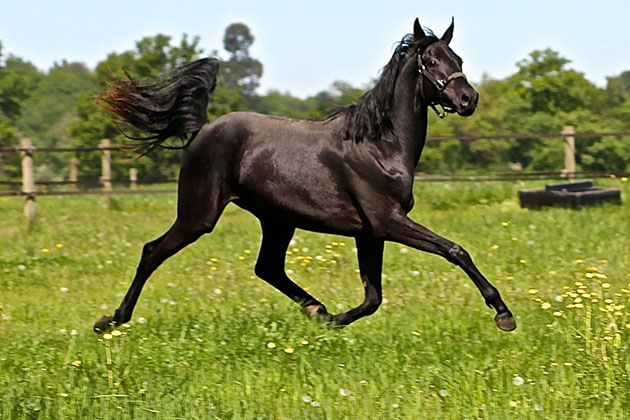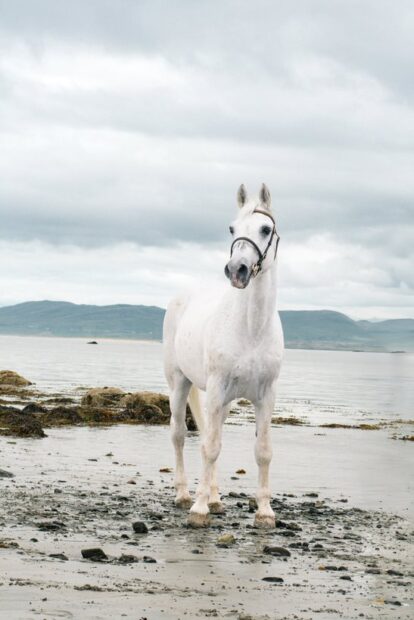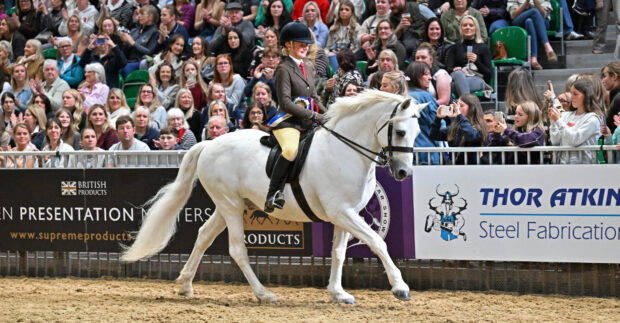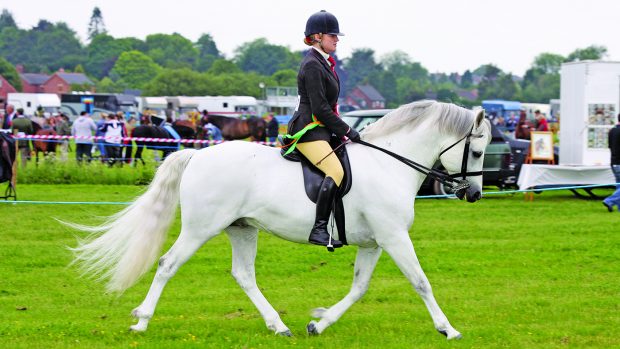The Connemara pony originates from the eponymous region in County Galway on Ireland’s west coast, a wild area of peatbogs, lakes, mountains, and rugged coastline.
The pony’s exact origins are uncertain – it has been theorised that their ancestors were the horses brought to Ireland by the Vikings; another foundation animal may have been the now-extinct Irish Hobby Horse, the warhorse of the 13th century. Whatever the native stock was, they bred with Andalusians when the Spanish Armada ran aground on the west coast of Co. Clare and Co. Galway in 1588 and their horses ran loose. The Spanish blood refined the tough, hardy local ponies.
The animals were further refined in the 18th and 19th Centuries, when they were crossed with Arabians, Hackneys and Thoroughbreds. By the early 20th Century, there were concerns that the breed was becoming too diluted. Subsequently, breeders formed the Connemara Pony Breeders’ Society in 1923, setting out to improve and preserve the native breed of Ireland, establishing a studbook in 1926.
Now there are Connemara breeders all over the world, including Britain, North America, across Europe, Australia, New Zealand, and South Africa.
The Connemara Pony Breeders’ Society describes the ponies as: “Compact, well-balanced riding type with good depth and substance and good heart room, standing on short legs, covering a lot of ground.” The head is “well-set onto neck. Crest should not be over developed. Neck not set too low. Good length of rein. Well-defined withers, good sloping shoulders.” The hindquarters must be “strong and muscular with some length, well-developed second thighs (gaskin) and strong low-set hocks.” The limbs should be strong and clean, with low-set hocks, short cannons and rounded, hard feet. Their movement is free and easy, active and ground covering but without excessive knee action. They should have a good temperament, kind enough for a child to handle, and be sound and surefooted with jumping ability.
Perhaps surprisingly for a pony breed no taller than 15hh, pure and part-bred Connemaras have competed at FEI levels of showjumping, eventing and dressage.
Stroller, a Connemara/Thoroughbred who was only 14.1hh, won 61 international showjumping competitions, including a silver medal in the Mexico Olympics in 1968. In 1935, a pure Connemara called Nugget cleared a 7’2 puissance wall at the Olympia Horse Show in London. During the late 1990s, a Connemara stallion named Erin Go Bragh competed at advanced level eventing in the United States, at the height of his career coming in eighth at Fair Hill, a CCI3* in Maryland. He was also popular as a stud, siring 225 offspring. Another American Connemara/Thoroughbred, a 14.2hh grey gelding called Seldom Seen, competed against warmbloods in grand prix dressage in the late 1980s with rider Lendon Gray. Gray told Eurodressage: “This was the time that people started to flock to Europe to buy big fancy warmbloods. The average American couldn’t afford to do that, so these people loved to see the pony; with average gaits do so well. He proved what good training could accomplish. To this day I get letters from people saying that seeing Seldom Seen gave them a boost to go home and work harder on their own unimpressive dressage horse.”
Serena Cookson, of Tulira Connemaras, explained to H&H: “The breed is second to none in terms of temperament and versatility and so they are a fun pony to interact with and be a part of. We meet such a mix of people along the way and the ponies when sold go on and do such a variety of jobs.
She added: “They can suit a whole number of riders from children to young professionals and adults of all ages. This is what makes them such a valuable pony to any family or competition home.”
Another breeder, Robbie Fallon, who owns Cashel Bay stud in Co. Galway, came from a horsey family in the Connemara region and bought his first pony in 1968, a mare who worked the land at his uncle’s farm for 21 years. He told H&H: “As a boy, I went to the Connemara pony shows with older breeders and my love spanned from there.” He started breeding the ponies in 1992, and explained: “I love Connemaras because they are a very versatile pony. They can be ridden by a child or an adult. They excel in all disciplines — ridden, working hunter, dressage, eventing, showjumping, etc. They have a great temperament so they are also ideal for anyone looking for a recreational pony or a pony to have around children.”
Article continues below…
You might also be interested in:

What is a KWPN? H&H explains…
Discover everything you need to know about this Dutch breed of horse

Subscribe to Horse & Hound magazine today – and enjoy unlimited website access all year round
The ponies are generally healthy and hardy, though like many moorland breeds, they can suffer from laminitis and obesity if fed too rich a diet. There is also a genetic disease in the breed, called Hoof Wall Separation Disease, where the weight-bearing borders of the hoof wall separate from the underlying structure, leaving the horse bearing weight on the sole of its foot. Some ponies with this condition can be managed (but not ridden); others need to be put down. It is thought to be an autosomal recessive condition, meaning both parents must be carriers of the faulty gene and the offspring has a one-in-four chance of getting the condition. A genetic test for this disorder has been available since 2014, but it’s optional. The largest uptake of the test has been in Australia and the United States, but the three largest producers of Connemaras, Ireland, France, and the UK, respectively, showed very low uptake. According to the Connemara Pony Research Group, an international research collective gathering data on HWSD, 51 foals born in Ireland in 2017 had the disease. As the condition appears in foals (and animals with it don’t live that long), anyone breeding Connemaras, or buying a foal or a pregnant mare should be aware of it and enquire if the mare and stallion have been tested.
For all the latest news analysis, competition reports, interviews, features and much more, don’t miss Horse & Hound magazine, on sale every Thursday.




